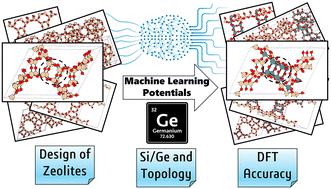当前位置:
X-MOL 学术
›
Catal. Sci. Technol.
›
论文详情
Our official English website, www.x-mol.net, welcomes your feedback! (Note: you will need to create a separate account there.)
Germanium distributions in zeolites derived from neural network potentials
Catalysis Science & Technology ( IF 4.4 ) Pub Date : 2024-08-28 , DOI: 10.1039/d4cy00763h Indranil Saha 1 , Andreas Erlebach 1 , Petr Nachtigall 1 , Christopher J. Heard 1 , Lukáš Grajciar 1
Catalysis Science & Technology ( IF 4.4 ) Pub Date : 2024-08-28 , DOI: 10.1039/d4cy00763h Indranil Saha 1 , Andreas Erlebach 1 , Petr Nachtigall 1 , Christopher J. Heard 1 , Lukáš Grajciar 1
Affiliation

|
Germanosilicate zeolites have played a pivotal role in the recent surge in synthesis of novel zeolite topologies. This success has been attributed to the combined effect of the high hydrolytic lability and specific distribution of germanium within the zeolitic framework, e.g., favoring the double four-ring (D4R) structural units. While experimental determination of germanium distributions remains limited, their in silico investigation has been hampered by the high computational cost of ab initio calculations. To overcome these limitations, we have developed neural network potentials (NNPs) that can efficiently explore a wide range of distributions in germanosilicate zeolites, while maintaining the accuracy of the ab initio (dispersion-corrected GGA DFT) training dataset. Through comprehensive screening of low-energy germanium distributions for five zeolite topologies (UTL, BEC, UOV, IWW and *CTH) across a broad range of Si/Ge ratios, we have identified a key factor governing the distribution of germanium in these D4R-containing zeolites, which is the tendency of germanium to cluster. The clustering initiates at the D4R units, leading to a preference to occupy these units at low to medium Ge loading (Si/Ge ≥ 5). However, at high Ge loading, the Ge tends to phase separate into Ge-rich and Ge-poor regions, regardless of the specific structural unit. The zeolite topology was shown to be capable of modulating these trends in germanium distribution (e.g., UTL strongly favors D4R occupation even for low Si/Ge ratios), which suggests the possibility to develop design strategies for targeted zeolite synthesis. The NNPs presented herein enable rapid evaluation of these design strategies across a wide range of candidate zeolite structures and experimentally relevant Si/Ge ratios.
中文翻译:

来自神经网络势的沸石中的锗分布
德国硅酸盐沸石在近年来新型沸石拓扑合成的激增中发挥了关键作用。这一成功归因于高水解不稳定性和锗在沸石骨架内的特定分布的综合作用,例如,有利于双四环(D4R)结构单元。虽然锗分布的实验测定仍然有限,但从头计算的高计算成本阻碍了计算机研究。为了克服这些限制,我们开发了神经网络势(NNP),它可以有效地探索硅酸沸石中的各种分布,同时保持从头算(色散校正的 GGA DFT)训练数据集的准确性。通过对五种沸石拓扑(UTL、BEC、UOV、IWW 和 *CTH)在广泛的 Si/Ge 比率范围内的低能锗分布进行全面筛选,我们确定了控制这些 D4R- 中锗分布的关键因素。含有沸石,这是锗的团簇倾向。聚类从 D4R 单元开始,导致优先以低至中等 Ge 负载(Si/Ge ≥ 5)占据这些单元。然而,在高Ge负载量下,无论具体的结构单元如何,Ge往往会相分离成富Ge区域和贫Ge区域。沸石拓扑结构被证明能够调节锗分布的这些趋势(例如,即使对于低Si/Ge比率,UTL也强烈支持D4R占据),这表明开发用于目标沸石合成的设计策略的可能性。 本文提出的 NNP 能够在各种候选沸石结构和实验相关的 Si/Ge 比率中快速评估这些设计策略。
更新日期:2024-08-28
中文翻译:

来自神经网络势的沸石中的锗分布
德国硅酸盐沸石在近年来新型沸石拓扑合成的激增中发挥了关键作用。这一成功归因于高水解不稳定性和锗在沸石骨架内的特定分布的综合作用,例如,有利于双四环(D4R)结构单元。虽然锗分布的实验测定仍然有限,但从头计算的高计算成本阻碍了计算机研究。为了克服这些限制,我们开发了神经网络势(NNP),它可以有效地探索硅酸沸石中的各种分布,同时保持从头算(色散校正的 GGA DFT)训练数据集的准确性。通过对五种沸石拓扑(UTL、BEC、UOV、IWW 和 *CTH)在广泛的 Si/Ge 比率范围内的低能锗分布进行全面筛选,我们确定了控制这些 D4R- 中锗分布的关键因素。含有沸石,这是锗的团簇倾向。聚类从 D4R 单元开始,导致优先以低至中等 Ge 负载(Si/Ge ≥ 5)占据这些单元。然而,在高Ge负载量下,无论具体的结构单元如何,Ge往往会相分离成富Ge区域和贫Ge区域。沸石拓扑结构被证明能够调节锗分布的这些趋势(例如,即使对于低Si/Ge比率,UTL也强烈支持D4R占据),这表明开发用于目标沸石合成的设计策略的可能性。 本文提出的 NNP 能够在各种候选沸石结构和实验相关的 Si/Ge 比率中快速评估这些设计策略。





































 京公网安备 11010802027423号
京公网安备 11010802027423号